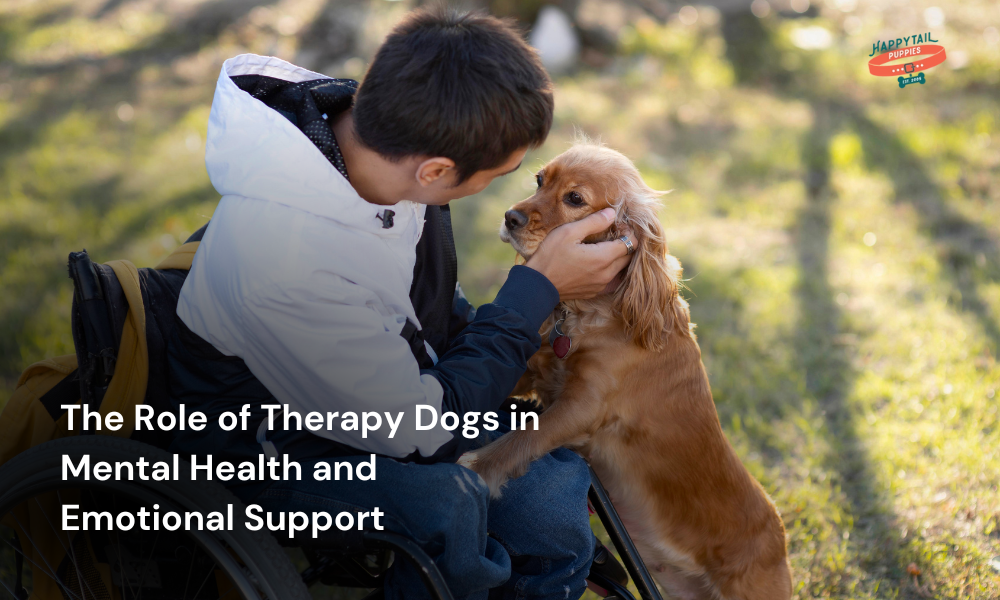The Role of Therapy Dogs in Mental Health and Emotional Support
There was a time in mankind’s history when we decided to team up with wolves. We built a symbiotic relationship with these four-legged creatures: we protected them, and they protected us. We showed them affection, and they returned it with loving licks. Both companionship and utility can be found in these intelligent creatures, and our relationship with them has only grown stronger over time.
As we spent more time with our furry friends, a remarkable discovery was made: dogs aren’t just good for farming, hunting, protection, and companionship, but they actually have a positive impact on our mental and physical well-being. In this blog post, we’ll speak about the fairly modern phenomenon of therapy dogs and the role they play in modern human lives.
What are Therapy Dogs?
A therapy dog is a good boy with a fancy certificate that proves they’ve undergone professional training to provide comfort and relieve stress to their owners, handlers, or anyone who needs it. These dogs can often be found in hospitals and schools, accompanying, for example, a human who may experience panic attacks or anxiety in crowded places.
For a dog to become a therapy dog, they must have a calm temperament, be highly sociable, be comfortable in new and distracting environments, be non-aggressive, and possess the intelligence required to learn commands and go through training. While most dog breeds can become therapy dogs if they possess the above-mentioned qualities, breeds such as Golden Retrievers, Labradors, and Poodles are at the top of the list thanks to their naturally gentle, affectionate, sociable, and intelligent nature.
What do Therapy Dogs Do?
Therapy dogs' primary goal is to provide comfort and relieve the stress of an individual who may potentially be going through something traumatic. Now, the specifics of a therapy dog's job description vary based on their training, areas of expertise, and personality, as well as from one institution to another (yes, that was a real sentence). However, to put it in a nutshell, all therapy dogs perform the practice of Animal-Assisted Therapy.
Diving into the Specifics
Therapy dogs have been shown to have a positive impact in combating several mental health conditions such as depression and anxiety, as well as assisting people on the autism spectrum. Therapy dogs for autism help those on the spectrum with several issues they may face, such as assisting with sensory signals (recognising alarms and horns), improving social skills (by being an endlessly patient companion that they can practice talking to), maintaining a routine and building discipline, developing a sense of independence and caretaking (feeding and taking the dog for walks), as well as offering a calming effect through their sheer presence, reducing the chances of a breakdown or aggression.
Therapy dogs for anxiety play quite a similar role by being a natural and supportive companion to help them calm down during challenging moments or anxiety attacks.
Clearing Common Misconceptions
Using therapy dogs is still reaching the mainstream to a certain extent, so naturally, there are some misconceptions floating around about the entire ordeal. Let’s clear the air about some common therapy dog misconceptions:
Therapy Dogs Are the Same as Service Dogs
One of the most common misconceptions is that therapy dogs and service dogs are the same, as both provide support. While that is true, it’s support of a different kind. Service dogs are trained to perform tasks for individuals with physical disabilities, like guiding those visually impaired, alerting for seizures, and standing guard or fetching help. Guide dogs could be considered a subcategory of the service dog faction.
Therapy dogs, on the other hand, provide emotional support, comfort, and companionship to people in hospitals, schools, nursing homes, or other settings.
Therapy Dogs Only Provide Comfort
Therapy dogs do more than just play and show affection to their pet parents in order to ease off their stress; they play a genuine therapeutic role in the overall well-being of an individual. Therapy dogs for anxiety can help individuals tackle situations they would be too afraid to confront alone, whereas, for someone who’s suffering from depression, a therapy dog can help them build a routine and get out of the house.
Therapy Dogs Are Always Allowed Everywhere
Alas, while service dogs are protected under laws like the Americans with Disabilities Act (ADA) and have access to most public places, therapy dogs do not have the same legal rights to access all areas. While they are often allowed in hospitals, schools, and nursing homes, their access is not as unrestricted, and their entry may be restricted in certain public spaces.
Types of Emotional Support Dogs
An emotional support animal (ESA) plays an impactful role in the life of an individual suffering from mental health struggles, be it panic attacks, depression, loneliness, PTSD, or anxiety. Whilst all breeds can become emotional support dogs, there are a few that naturally excel at it. Let’s take a look at them below:

Golden Retriever
This likely comes as no surprise to anyone who has been around them. Goldens are angels, extremely calm and affectionate dogs with a zeal for life. They’re great first time owners and are often recommended as therapy dogs for those in need of emotional support.
Poodle (Standard, Miniature, TeaCup, or Toy)
Poodles are quite similar to Golden Retrievers in terms of their personality, but their hypoallergenic coats make them suitable for individuals with allergies. They are quite active and alert, so they’re well-suited for high-energy individuals.
Shih Tzu
These dogs are known for their affectionate, calm, and friendly nature. Being small dogs, they’re excellent for those afraid of bigger dogs. They have a low-energy nature and are very loyal.
Dachshund
Small but with a big personality, these dogs are quite loving and energetic, always up to something. They’re great at keeping individuals entertained as well as providing comfort when needed.
Conclusion
If you’re considering animal therapy, it’s best to have a consultation with a doctor or a mental health practitioner to truly grasp it and ensure it is the right therapy for you. Other than that, it is also important to remember that if you’re getting yourself an emotional support dog, you’re still getting yourself a regular dog in every sense so that means taking care of them like family. That means feeding, nurturing, entertainment, and even getting insurance for them. They’re going to be your pet and be a part of your home, so it’s best to opt for a breed that fits your lifestyle.
FAQs
Who started Animal Assisted Therapy?
Dating back Animal Assisted Therapy (AAT) is a herculean task and cannot particularly be narrowed down to a single individual. However, notable contributors to it include Florence Nightingale (founder of modern nursing), Sigmund Freud (known as the father of psychoanalysis) and Boris Levinson (often referred to as "the father of AAT."). Other notable names include:
- Samuel Corson
- Earl and M. B. Miller
Do I require a license to get a therapy dog?
No, the individual who has a therapy dog does not require a license but the dog must meet specific criteria and undergo professional training and get certification from a recognised organisation like Therapy Dogs International (TDI), Alliance of Therapy Dogs (ATD) or Pet Partners.
Do Emotional Support Animals have rights?
Unlike service dogs, therapy dogs lack many rights. However, the Fair Housing Act mandates “reasonable accommodations” for them and they are generally allowed in most buildings. Airlines, for example, aren’t by law required to accommodate therapy dogs.



